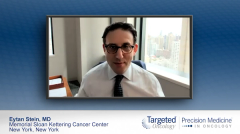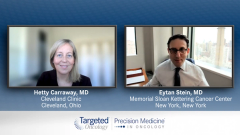
Intensive Induction Therapy In AML
Hetty Carraway, MD, describes the criteria used to determine if a patient with newly-diagnosed acute myeloid leukemia is suitable for intensive induction therapy.
Episodes in this series

Eytan Stein, MD: Dr Carraway, what are some of the criteria that you use to determine whether a patient with newly diagnosed AML [acute myeloid leukemia] is fit or unfit for intensive induction chemotherapy?
Hetty Carraway, MD: I agree with you, Eytan, about a lot of what you said in terms of age not being the true issue but rather the fitness of the patient, however you describe it, such as fit vs unfit. Some of what you were directly talking about were the comorbidities that our patients have and their relative fitness in terms of activity level. Additionally, to get into some of the details, our patients with issues with cardiovascular disease, pulmonary disease, and renal disease can limit our ability to give intensive chemotherapy. I love that you walked us through the different types of intensive therapy more often considered for our patients who are fit, and then that backbone of 7+3 [7 days of cytarabine and 3 days of an anthracycline] and then adding whatever additional agent that we think may be of benefit in terms of improving remission rates and overall survival for those specific cohorts of patients.
For others, and those over age of 75 years in particular, we’ve learned that combination venetoclax plus azacitidine can be an important regimen to use in the upfront setting for our older patients. It’s interesting. I might turn to you, Eytan, to talk a little about some of the toxicities with the intensive therapies that you walked through. But as much as we call venetoclax plus azacitidine a nonintensive approach, there are some important considerations for us to think about. For much of our discussion, we’ll talk about some of the ways we manage those toxicities and modify or deal with dose modifications or interruptions, not just with azacitidine plus venetoclax but even with some of the other induction therapies that you just talked about. With that, I’m going to turn to you. How do manage some of these toxicities associated with intensive induction therapy? How do you potentially modify what you’re doing, if at all?
Eytan Stein, MD: When it comes to intensive induction therapy, there are toxicities that we always see and then toxicities that we sometimes see but you need to watch out for. When you’re giving someone 7+3, 7+3 or with a targeted agent, or another intensive induction approach, such as FLAG-IDA [fludarabine, cytarabine, idarubicin, G-CSF]—if you’re in Europe, you might give something slightly different—there are things that happen to everyone. The intensive chemotherapy is toxic to not only bone marrow cells but also to gastrointestinal cells that are dividing.
In addition to the anticipated cytopenias, which all oncologists know about, and the need for frequent blood and platelet transfusions, the gastrointestinal tracts of these patients—specifically the small and large intestine—will be damaged, which can lead to various infectious complications, such as bacteremias or typhlitis, which is a neutropenic enterocolitis. We looked at this recently, and 80% to 90% of our patients who get intensive induction chemotherapy will have a neutropenic fever at some point. Identifying the source of the fever can be more complicated because it usually comes down to transient bacteremia. That’s the major toxicity that we see.
We see patients get pneumonias. I still think that intensive induction chemotherapy requires an admission because these patients can get septic very quickly, and you want to be able to jump on any infectious complications with the appropriate antimicrobial management. Certainly, things like nausea and vomiting are important toxicities, but they’re much better controlled than they were 30 years ago because we have outstanding anti-emetics that have been introduced for a wide variety of chemotherapeutic regimens.
The things you need to look out for that are less common but can be serious include the cardiovascular toxicity associated with anthracyclines. At our institution, before patients start an anthracycline, we still do pretreatment echocardiograms on all patients who are going to get intensive induction chemotherapy to make sure they don’t have any baseline cardiovascular abnormalities or problems with their ejection fraction.
The other thing you have to watch out for is tumor lysis syndrome. There’s a group of patients who have rapidly proliferative disease and are at high risk of developing tumor lysis syndrome. Because of that, you’re going to do the usual tumor lysis prophylaxis, such as giving allopurinol as prophylaxis and hydrating the patients fairly aggressively. The benefit of this discussion is that people have been giving intensive induction for so long that many of us or all of us are very familiar with the toxicities associated with it. The problem is with some of the newer regimens, where we don’t have as much experience managing the toxicities that are somewhat unique or slightly different with those agents.
Transcript edited for clarity.











































